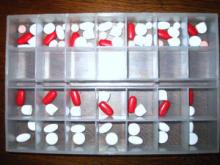Many patients getting multiple prescription medications take their drugs inefficiently through the day, potentially leading to missed doses and incorrectly administered drugs, researchers reported in the Feb. 28 issue of the Archives of Internal Medicine.
The study’s authors said that especially patients of low literacy need more education on how to take multiple prescriptions, given heightened concerns over medication safety and adherence. "In particular, strategies are needed to help patients not only to understand how to take a particular medicine but also to consolidate and simplify how to take an entire drug regimen," the authors wrote (Arch. Intern. Med. 2011 Feb. 28;171:300-5).
Led by a team from Northwestern University, Chicago, the researchers conducted interviews with 464 adults aged 55-74 years who were receiving care either at an academic general medicine practice or at a health center in Chicago.
Participants were given a hypothetical seven-drug regimen and asked to describe how and when they would take the oral medications over a 24-hour period. Ideally, the medications would be taken in just four sessions during the 24-hour period, said the researchers. Just 15% of the patients organized the medication regimen into four or fewer dosing sessions per day, the researchers found.
On average, participants identified six times when they would take the seven drugs over 24 hours, and nearly one-third of the patients (29%) said they would take doses seven or more times per day. People who said they would dose most frequently tended to have lower literacy rates than did other study participants.
Instructions for two of the seven drugs were identical, but 31% of the participants would not have taken these medications at the same time, the researchers found. Another set of drugs had similar instructions, although only one of these medications said to take it "with food and water." Half of the study participants said they would take the three medications at different times.
In addition, when the medications used different words to describe the same dose frequency – for example, "every 12 hours" vs. "twice daily" – four out of five participants failed to consolidate the medication schedules.
The study shows that most patients probably self-administer multiple-drug regimens more times a day than necessary, the authors said. "This increased complexity, at the very least, translates to taking medication too often each day, leading to substantial interference with patients’ lives," they wrote. "As a result, doses may be frequently missed or incorrectly administered."
Variations in how instructions are written, both in describing the timing of doses and including instructions such as "take with food," also can confuse individuals and prevent them from consolidating regimens, the authors said. Patients "might not understand that they can take different medications at the same time," the researchers speculated.
Because many elderly and chronically ill patients take far more medications than in the study’s seven-drug regimen, the findings could underestimate the potential for confusion among older adults when trying to streamline and manage their daily prescriptions, the authors said.
Physicians can help their patients by providing standard, explicit written instructions, but patients probably need spoken communication with their physicians and pharmacists about organizing their prescriptions, the authors concluded. They added that public health initiatives can help patients learn how to take prescription medicines and when it’s safe to take them together.
The authors reported no financial disclosures.


